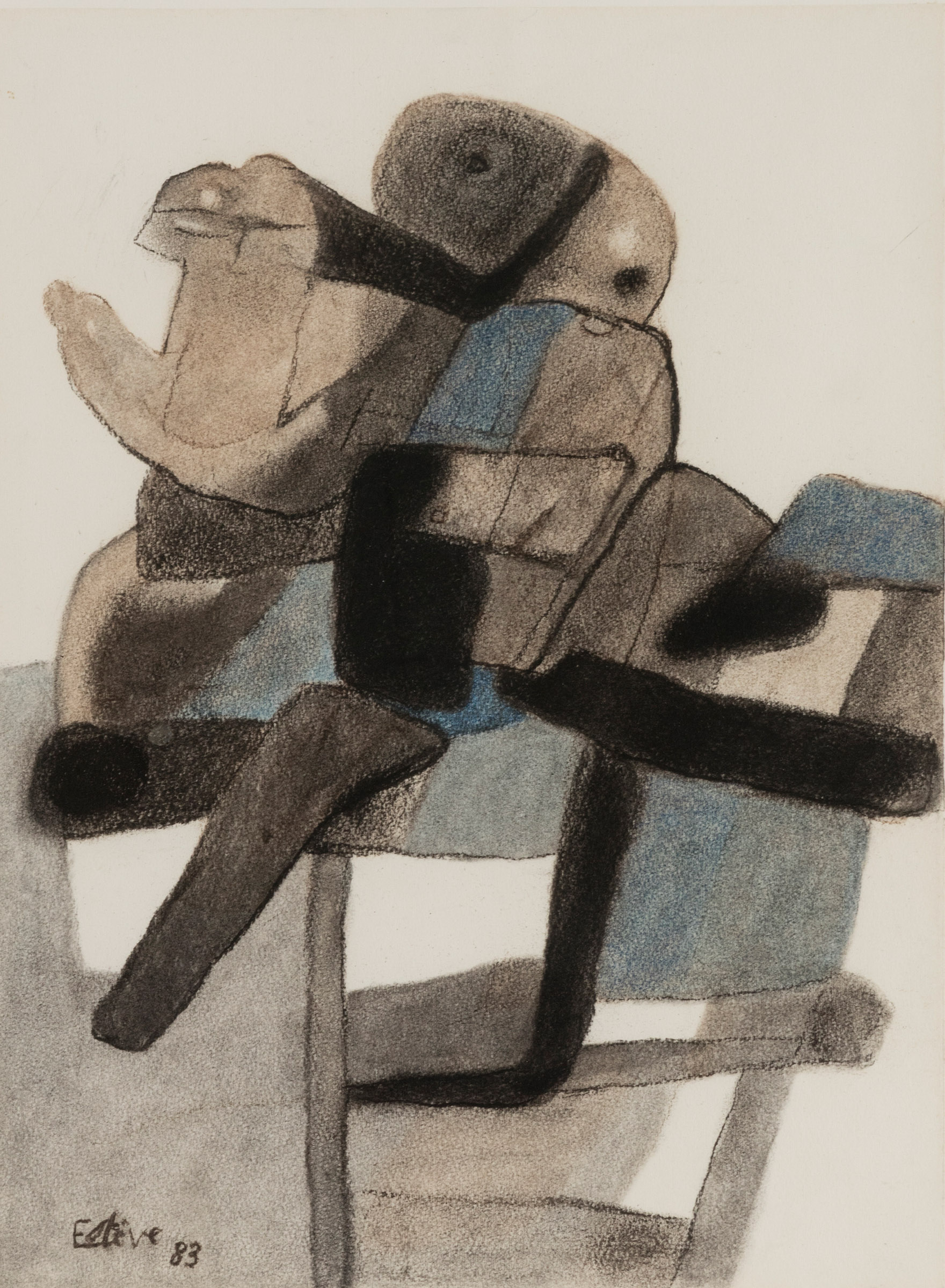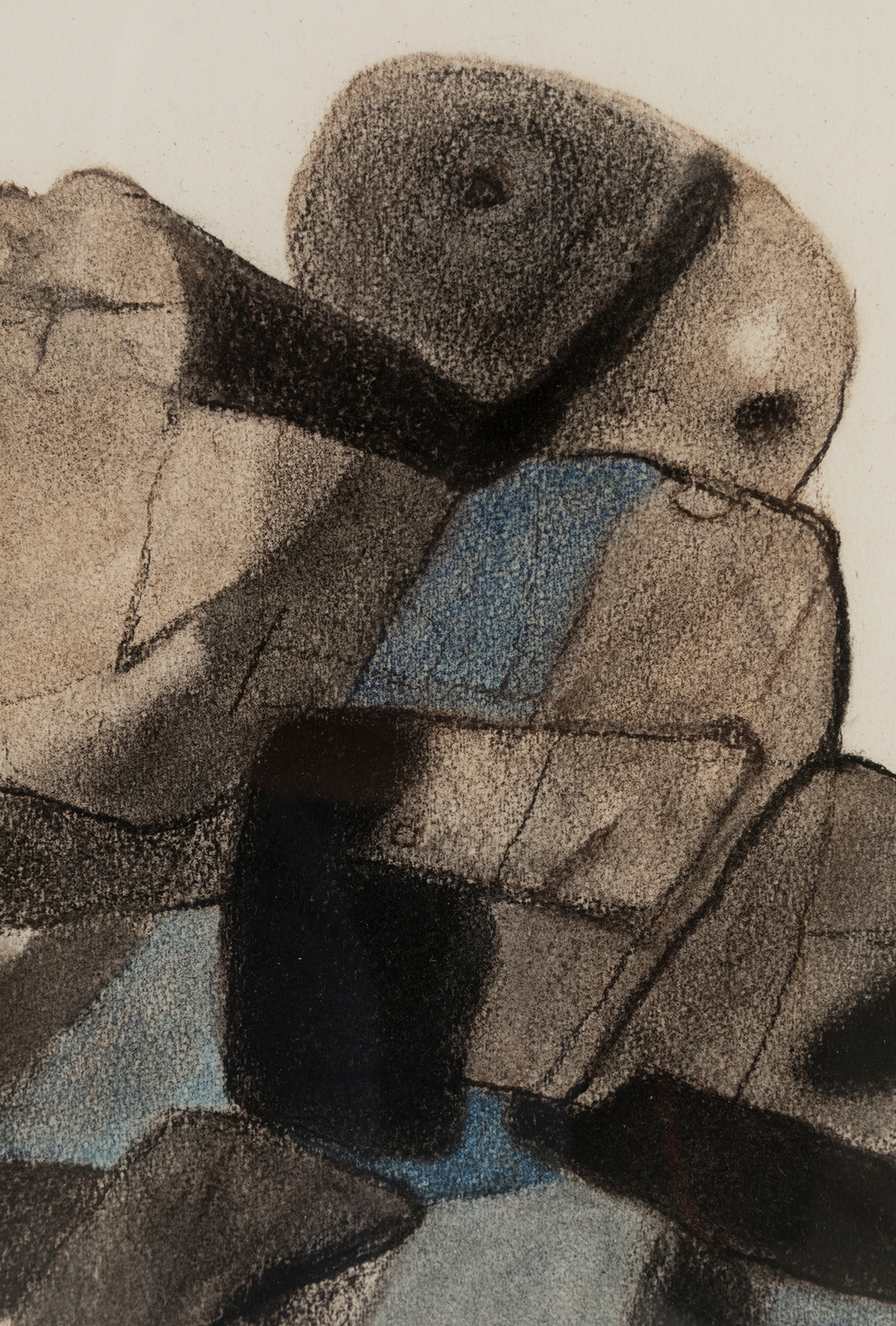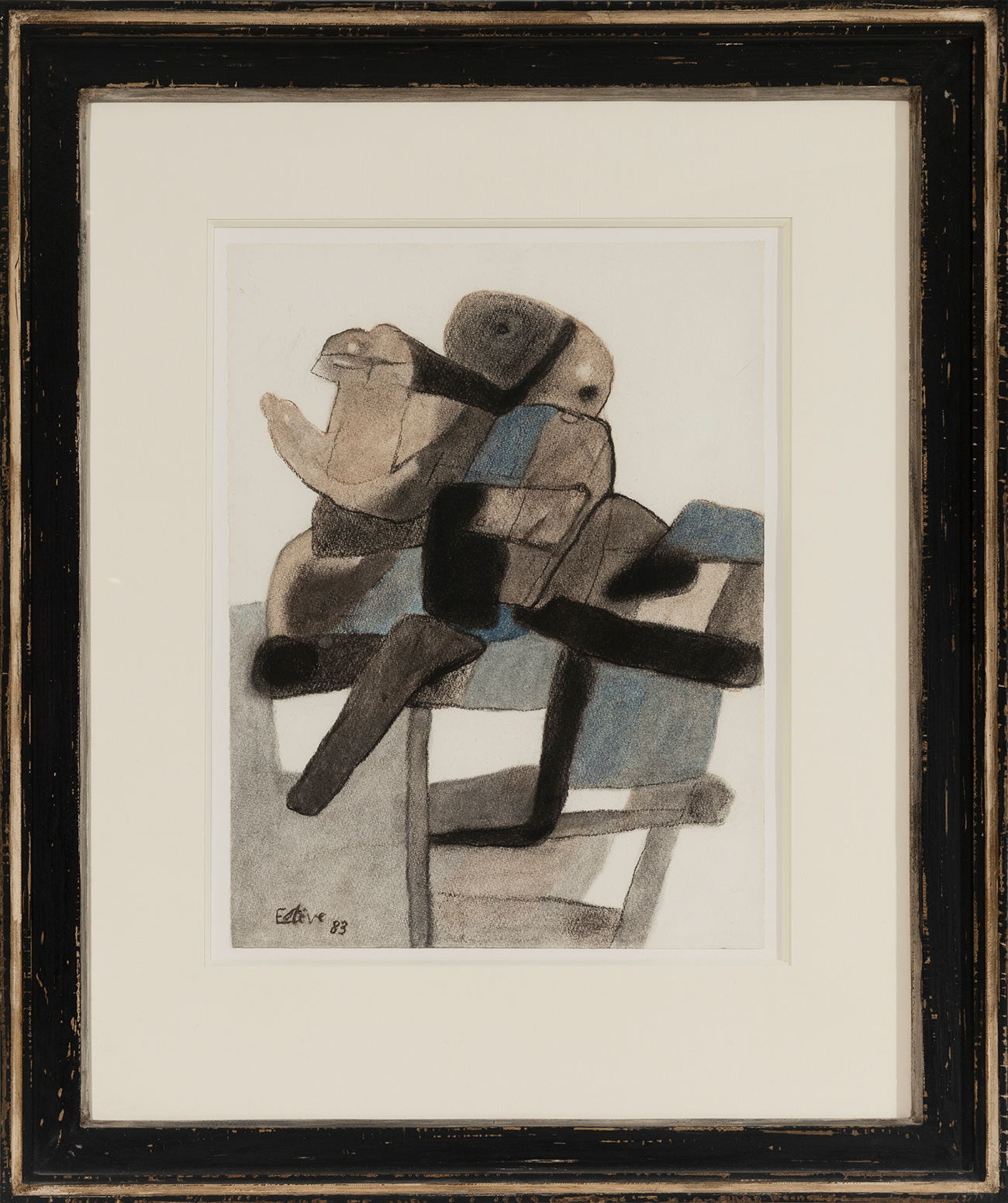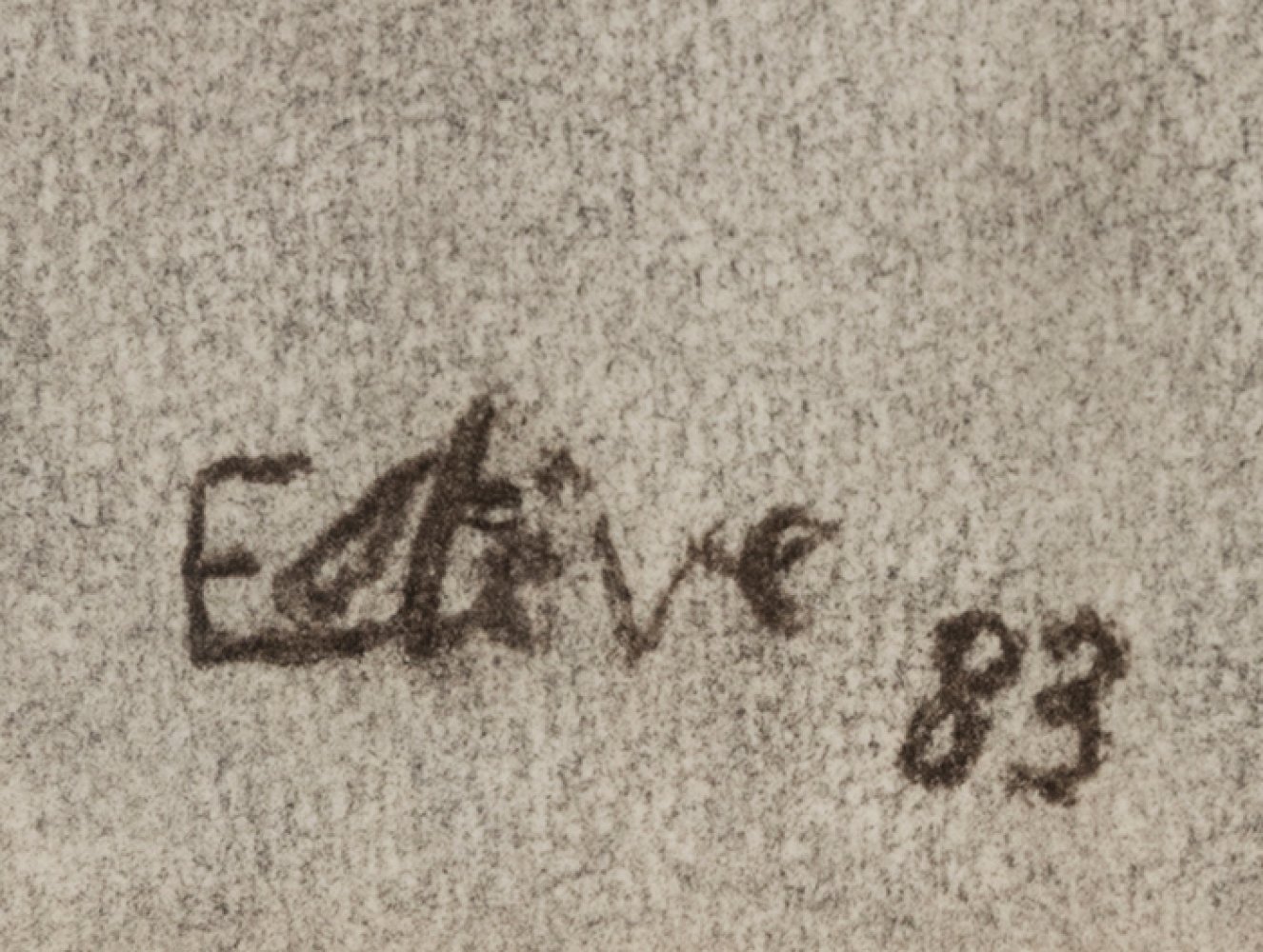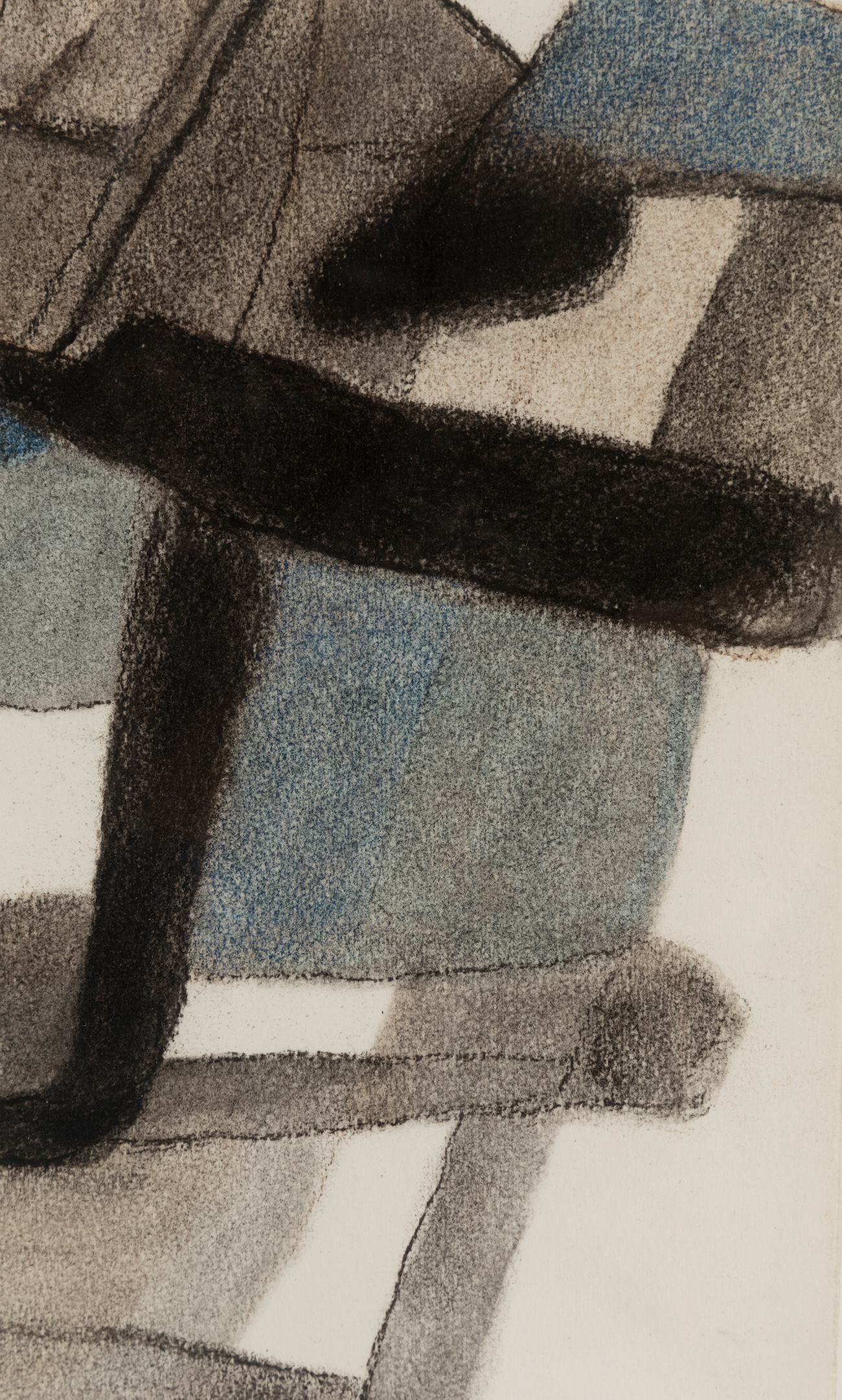58
MAURICE ESTÈVE (Culan, France, 1904-2001)."Jeune cavalier, 1983.Pastel on paper.Provenance: Claude
"Jeune cavalier, 1983.
Pastel on paper.
Provenance: Claude Bernard Gallery (Paris).
Presents inventory number of the Bernard Gallery: IBERNARD 42.
Signed and dated in the lower left corner.
Measurements: 41.5 x 31 cm; 71 x 58 cm (frame).
"Jeune Cavalier", (Young Horseman) is the title of this work which, despite its abstract aesthetic language, does not abandon the idea of reality, thus creating an image which appeals to the viewer, in an evocative way, forcing him to recognise the forms of the horse and rider in this work. The use of dark tones based on ochre, black and blue are characteristic of a stage of maturity of the artist, who abandoned his colourful compositions in favour of a more settled and sober chromatic range. In this work the artist uses a language based on irregular geometry, organic in both its outline and its colours. It is an open style, whose basic characteristic is the conception of the pictorial surface as a whole, as an open field, without limits and without hierarchy. Thus, as we see here, the pictorial forms are the result of a thought-out composition and experimentation, with an image of a gestural nature, are not limited to a composition but go beyond it, indicating to the spectator that they are forms, ideas or suggestions that go beyond the boundaries of the purely pictorial.
Maurice Estève moved to Paris in 1913, where he began his training as an artist. He worked for a year as a designer in a textile factory in Barcelona in 1923. During his visits to the Louvre in the 1920s, Estève was particularly impressed by the painters Jean Fouquet and Paolo Uccello, although Paul Cézanne exerted a greater influence on Estève's work. Maurice Estève was largely self-taught, only attending the free studio of the Académie Colarossi in 1924, where he tried to constructively implement his motifs on the model of Georges Braque and Fernand Léger, thus creating a kind of Cubist Fauvism.
Estève began to move away from realism in 1928, and in the following years he was influenced by Léger, Matisse and Bonnard. His first solo exhibition was held at the Galerie Yvangot, Paris, 1930. He worked as an assistant to Robert Delaunay on huge decorative panels for the Paris International Exhibition of 1937. In the 1940s, his stylised figure compositions, still lifes and landscapes in strong colours gradually became completely abstract, with tightly knit interlocking forms in rich, bold colours. Esteve's extensive oeuvre was not limited to the genre of painting. He was also active in collage, textile design and murals. Maurice Estève participated in the 1954 Venice Biennale. His work, like the works of his art colleagues Riopelle and Bazaine, established a new pictorial language: lyrical abstractions with the aim of representing form and colour with an almost poetic attitude.
"Jeune cavalier, 1983.
Pastel on paper.
Provenance: Claude Bernard Gallery (Paris).
Presents inventory number of the Bernard Gallery: IBERNARD 42.
Signed and dated in the lower left corner.
Measurements: 41.5 x 31 cm; 71 x 58 cm (frame).
"Jeune Cavalier", (Young Horseman) is the title of this work which, despite its abstract aesthetic language, does not abandon the idea of reality, thus creating an image which appeals to the viewer, in an evocative way, forcing him to recognise the forms of the horse and rider in this work. The use of dark tones based on ochre, black and blue are characteristic of a stage of maturity of the artist, who abandoned his colourful compositions in favour of a more settled and sober chromatic range. In this work the artist uses a language based on irregular geometry, organic in both its outline and its colours. It is an open style, whose basic characteristic is the conception of the pictorial surface as a whole, as an open field, without limits and without hierarchy. Thus, as we see here, the pictorial forms are the result of a thought-out composition and experimentation, with an image of a gestural nature, are not limited to a composition but go beyond it, indicating to the spectator that they are forms, ideas or suggestions that go beyond the boundaries of the purely pictorial.
Maurice Estève moved to Paris in 1913, where he began his training as an artist. He worked for a year as a designer in a textile factory in Barcelona in 1923. During his visits to the Louvre in the 1920s, Estève was particularly impressed by the painters Jean Fouquet and Paolo Uccello, although Paul Cézanne exerted a greater influence on Estève's work. Maurice Estève was largely self-taught, only attending the free studio of the Académie Colarossi in 1924, where he tried to constructively implement his motifs on the model of Georges Braque and Fernand Léger, thus creating a kind of Cubist Fauvism.
Estève began to move away from realism in 1928, and in the following years he was influenced by Léger, Matisse and Bonnard. His first solo exhibition was held at the Galerie Yvangot, Paris, 1930. He worked as an assistant to Robert Delaunay on huge decorative panels for the Paris International Exhibition of 1937. In the 1940s, his stylised figure compositions, still lifes and landscapes in strong colours gradually became completely abstract, with tightly knit interlocking forms in rich, bold colours. Esteve's extensive oeuvre was not limited to the genre of painting. He was also active in collage, textile design and murals. Maurice Estève participated in the 1954 Venice Biennale. His work, like the works of his art colleagues Riopelle and Bazaine, established a new pictorial language: lyrical abstractions with the aim of representing form and colour with an almost poetic attitude.
8th November - 19th & 20th Century Arts
Sale Date(s)
Venue Address
General delivery information available from the auctioneer
Setdart offers Worldwide shipping
PICK UP IN ROOM: You can come and pick up your lots in our offices (Barcelona, Madrid or Valencia). At the moment of the withdrawal, you will be able to accept the current conditions of the lot by means of a document that you will sign.
YOU CAN SEND ANOTHER PERSON TO PICK UP: This person must present a signed authorization that you can find in our web page by accessing from BUY AT SETDART- LOGISTICS-DOWNLOAD AUTHORIZATION DOCUMENT. You can also send an e-mail with the requested data in AUTHORIZATION DOCUMENT to admin@setdart.com
Important Information
25% buyer´s premium
OR
21% buyer´s premium at www.setdart.com
Terms & Conditions
The maximum period to pay the lots is 7 working days. You can pay either via bank transfer or with credit card through our platform www.setdart.com (we only accept VISA or Mastercard).
BUYER´S PREMIUM: 22% Hammer price + 21% VAT from the buyer´s premium
If your piece has more than 100 years, our Ministry of Culture requires an export certificate in order for the piece to leave the country. Note that if the piece goes inside the EU, there is no cost for the export certificate. If the piece goes outside the EU, there is a cost for the export certificate. You can find more information in our Ministry of Culture website: https://www.culturaydeporte.gob.es/en/cultura/patrimonio/exportacionimportacion/exportacion/tasas.html
INQUIRIES: admin@setdart.com
Setdart guides you through the entire process, from the time of award to the day you receive your lot. Our logistics team will be happy to manage your transport, and will advise you on the best shipping method with professionals from the sector used to handling works of art and jewelry.
WE OFFER WORLDWIDE DOOR TO DOOR SHIPPING
PICK UP IN ROOM: You can come and pick up your lots in our offices. At the moment of the withdrawal, you will be able to accept the current conditions of the lot by means of a document that you will sign.
YOU CAN SEND ANOTHER PERSON TO PICK UP: This person must present a signed authorization that you can find in our web page by accessing from BUY AT SETDART-LOGISTICS-DOWNLOAD AUTHORIZATION DOCUMENT. You can also send an e-mail with the requested data in AUTHORIZATION DOCUMENT to admin@setdart.com
SETDART IS NOT RESPONSIBLE FOR THE STATE OF THE PARTS ONCE THEY LEAVE OUR FACILITIES. MRW SHIPMENTS: Once the payment is made, your lot will be packed for shipment, the logistics department will send you an e-mail notifying you of the day it leaves our warehouse, changes of address cannot be made after receiving this e-mail.
INSURANCE INCIDENTS: Coverage for the value of the auction up to 3000 ? per shipment, if the value of the auction is higher, Setdart will send you a quote including the additional insurance. The insurance company WILL NOT BE RESPONSIBLE FOR THE SHIPMENT THAT EXCEEDS THAT AMOUNT AND IS NOT FULLY INSURED. MRW INCIDENTS: Maximum notification 48 hours after receipt, after which the insurance company WILL NOT BE RESPONSIBLE AND NO CLAIMS WILL BE ACCEPTED.
E-MAIL LOGISTICS: logistica@setdart.com
PICK UP YOUR MESSAGES: You can send your own messaging, prior notice via e-mail that your shipment is ready, please note 3 or 4 days in advance. This type of shipment is packaged so Setdart will provide you with a quote.
EXPENSES FOR STORAGE: We inform you that if the purchased lot is not picked up within a month, you will be charged 30€ per week per lot. Setdart Online S.L., owner of the web site "setdart.com", "setdart.net" and "setdart.org", acts as a company of Spanish nationality inscribed in the Volume 36955, sheet 182, page B-293056 of the Mercantile Registry, with registered office at Calle Aragó













